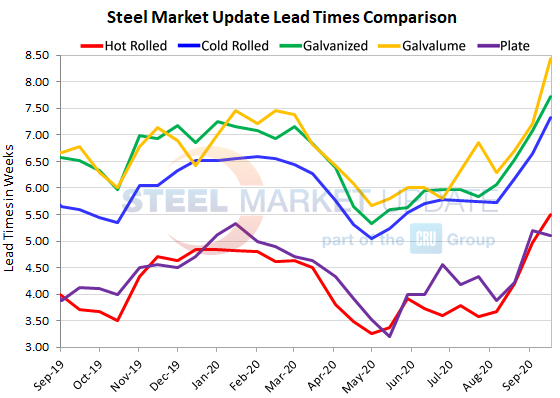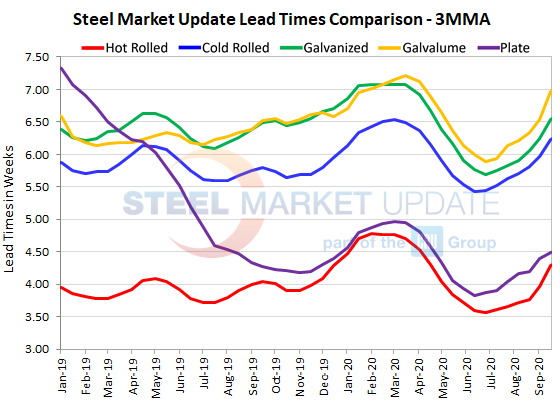SMU Data and Models

Steel Mill Lead Times: Extend Further
Written by Tim Triplett
September 17, 2020
Lead times for spot orders of flat rolled and plate steels continue to extend and are around two weeks longer than in April at the depth of the pandemic as demand recovers and supplies tighten. Lead times for hot rolled now average five and a half weeks, cold rolled and galvanized over seven weeks, and Galvalume, which is in short supply, over eight weeks. Lead times are an indicator of steel demand—longer lead times indicate the mills have more orders to process and are less likely to negotiate on prices.
According to Steel Market Update’s check of the market this week, hot rolled lead times now average 5.50 weeks, up from 4.97 weeks two weeks ago and 4.21 weeks at this time last month. HR lead times have stretched more than two weeks since hitting 3.25 weeks at the low point in April.
Cold rolled lead times have extended to 7.32 weeks from 6.64 weeks in SMU’s last check of the market. Like hot rolled, cold rolled lead times are more than two weeks longer than in April when they dipped to 5.04 weeks.
Galvanized lead times have extended to 7.73 weeks, up from 7.08 weeks in early September and 6.53 weeks a month ago. The current average Galvalume lead time has extended to 8.44 weeks, stretching by nearly two weeks since mid-August.
Plate lead times, averaging 5.11 weeks, have been relatively flat for the past two weeks.
Looking at three-month moving averages, which smooth out the variability in the biweekly readings, lead times for flat rolled and plate have continued moving outward since late June. The current 3MMA for hot rolled is 4.29 weeks, cold rolled is 6.23 weeks, galvanized is 6.53 weeks, Galvalume is 6.97 weeks and plate is 4.49 weeks.
Note: These lead times are based on the average from manufacturers and steel service centers who participated in this week’s SMU market trends analysis. Our lead times do not predict what any individual may get from any specific mill supplier. Look to your mill rep for actual lead times. Our lead times are meant only to identify trends and changes in the marketplace. To see an interactive history of our Steel Mill Lead Times data, visit our website here.



Tim Triplett
Read more from Tim TriplettLatest in SMU Data and Models

SMU’s June at a glance
A look at SMU data for the month of June.

SMU Survey: Buyers’ Sentiment rebounds from multi-year low
Both of SMU’s Steel Buyers’ Sentiment Indices edged higher this week. Current Sentiment rebounded from a near five-year low, while Future Sentiment rose to a two-month high

SMU flat-rolled market survey results now available
SMU’s latest steel buyers market survey results are now available on our website to all premium members.

SMU Survey: Sheet lead times pull back after early-June blip, plate holds
Following the uptick seen two weeks ago, lead times eased this week for all four sheet products tracked by SMU, while plate lead times held steady, according to this week’s market survey.

SMU Survey: Pricing power abruptly shifts to steel buyers
The majority of steel buyers responding to our latest market survey say domestic mills are more willing to talk price on sheet and plate products than they were earlier this month. Sheet negotiation rates rebounded across the board compared to early June, while our plate negotiation rate hit a full 100%.
